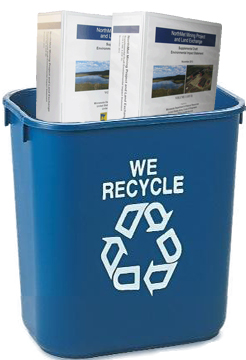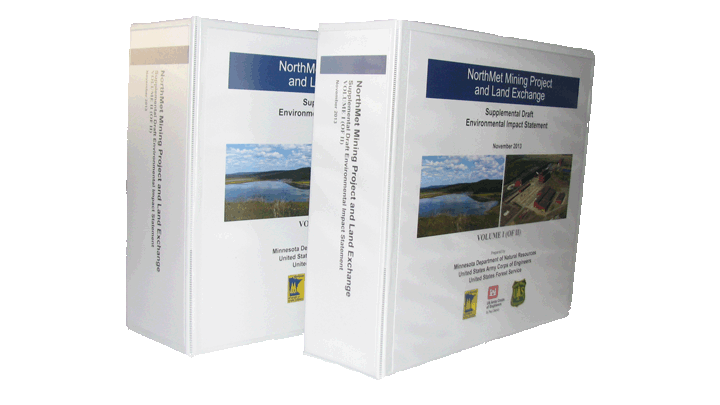It's time to put PolyMet on the shelf
By Elanne Palcich
February 15, 2014
Take a deep breath, Minnesota public. The Supplementary Draft Environmental Impact Statement (SDEIS) for PolyMet's proposed copper-nickel sulfide mine is available for public review through March 13, 2014. At stake is whether the state will uphold a project whose own modeling shows that the mine would require at least 500 years of water treatment after closure. Despite public astonishment and outcry, PolyMet and the agencies claim that 500 years of treatment is nothing out of the ordinary.
Where is our leadership?
When the only jobs that our political and business leaders can promote are those in which the workers will sacrifice the environment for future generations, then Minnesota has a deficit of responsible and ethical leadership.
Is it right to put our water resources at risk, when clean water is a main requirement for survival? Is it right to accept a project because it “minimizes risks,” when those risks will impact generations long after we are long gone.
Financial Assurance
Oh but, the agencies and mining companies claim, there will be financial assurance to make sure that there is money available to treat water pollution that would peak in 500 years.
So what is the cheapest amount of financial assurance that the mining company can get by with? You can bet your bottom dollar that it would be an amount negotiated to insure that Glencore-Xstrata, the largest single investor in PolyMet, doesn't threaten to back out. And after the 20 year projected life span of the mine, who's going to be counting anyway? Plus, the majority of the current agency personnel will be retired in 20 years. So who will be around to check on PolyMet in 20 years, let alone 200?
Financial assurance also ignores a basic fact. No amount of clean up money can restore the loss and contamination of ground and surface waters, along with the loss of forests, wetlands, and wildlife. Land dominated by leaching mine waste rock piles, tailings basins, and open pits is no longer usable. PolyMet's SDEIS needs to be shelved.
Reverse Osmosis and Water Capture
PolyMet is banking its water treatment on Reverse Osmosis (RO) technology. Yet in October of 2012, the Minnesota Pollution Control Agency (MPCA), in approving the reissuance of a permit for Mesabi Nugget iron mining, stated that "the immediate installation of additional wastewater treatment facilities [RO] would cause Mesabi Nugget undue hardship, and even a relatively small increase in operating costs would present the company with a significant competitive disadvantage."
So even if RO is listed in PolyMet's SDEIS, what guarantee do we have that our agencies will enforce its usage? Based only on a pilot test, how do we know that RO will actually be effective when all of the processing chemicals are added to the mix? And how is it possible that PolyMet will be able to capture all of the water from waste rock piles, tailings, roadways, etc. on the scale of the actual mine, not just as represented by computer models?
The SDEIS is unrealistic in its assumptions that run-off and water contamination can be prevented. It's also misleading to assume that RO will be either treatment- or-cost effective. Since there is no other long-term treatment plan, PolyMet's SDEIS needs to be shelved.
Replacing 19th Century Thinking
In the late 1800's, logging and mining interests invaded northeast Minnesota. A combination of greed, power, and ignorance pushed the Native Americans off their lands. This has never been fully acknowledged.
The Treaty of 1854 guarantees Minnesota's native populations hunting, fishing, and subsistence rights on Ceded Territories. Due to the impacts to water, wild rice, fish, and game, the concerns of the Tribal Nations should be enough to shelve the PolyMet project. If we are able to stop a proposed polluting mine in Minnesota, we would give hope to indigenous peoples throughout the world who are fighting the destruction of their lands.
Agency Bureaucracy
There is something wrong with the current structures of our regulatory agencies. For example, the U.S. Forest Service (USFS) could have said no to PolyMet's open pit proposal, because open pit strip mining is not allowed on public land purchased under the Weeks Act of 1911 for watershed protection. Instead, the Forest Service is negotiating a land exchange with PolyMet.
The MPCA, meanwhile, has a backlog of expired taconite mining permits. For example, Minntac's waste water treatment facility permit expired in 1989, and its tailings basin permit in 1992. Minntac's waste pit is polluting nearby water with sulfate concentrations up to 60 times higher than the state's limit (Environmental review sought for Minntac expansion, Star Tribune, May 10, 2013). While the MPCA works to catch up on permit reissuance, taconite mine expansion continues to result in loss of wetlands, spewing of mercury into the air from stack emissions, and leaching of sulfates and heavy metals from tailings basins.
The Department of Natural Resources (DNR) has a particularly conflicted nature, because it is divided into an Ecological Unit and the Division of Lands and Minerals. DNR Lands and Minerals has been actively promoting and assisting with the development of sulfide mining plans.
On a statewide level, the DNR is dealing with a host of water related problems: ground water depletion in the metro area, nitrate contamination of water in large scale farming regions, depletion of aquifers in areas with heavy corn production for ethanol, and potential water depletion and contamination with proposed frac sand mining. In northeast Minnesota, the DNR must deal with mercury contamination of fish, the loss of wild rice due to sulfate contamination, and depletion and contamination of water due to current mining as well as proposed sulfide mining.
In addition, the DNR must address the precipitous decline of the moose population and loss of wildlife corridors and habitat due to mining expansion, while simultaneously dealing with the impacts of climate change. The DNR is also responsible for protecting the endangered lynx population. None of this is adequately addressed in the PolyMet SDEIS. The dual mandate of the agency is preventing the DNR from fulfilling its own environmental missions.
Our agencies have become a political and bureaucratic quagmire, and are not capable of responding in a timely manner to current multiple threats. They are, however, going full speed ahead with the process to permit a mine that will leave behind a more- than -500 year legacy of water pollution.
On the Shelf
PolyMet should have been shelved long before this arduous and expensive environmental process drained our agencies of time, effort, and money that would be better spent on trying to clean up and fix existing problems.
The USFS could have stopped PolyMet by refusing a land exchange. The loss of wetlands could have stopped the project because of the no-net-loss policy mandated by State and Federal law. The EPA rating of PolyMet's draft EIS in 2010 could have stopped the project, because it declared the mine plan to be environmentally unacceptable and inadequate, especially in regard to ground water analysis.
The project could be stopped due to existing pollution coming from the LTV tailings basin purchased by PolyMet, due to no adequate analysis of cumulative impacts to the region, and due to lack of analysis of episodes of rainfall that might result in an overflow of contaminated water into the environment.
And surely a plan that would require treating water pollution for at least 500 years, in order to protect the internationally significant headwaters of Lake Superior, is enough to stop this project. Furthermore, State law mandates that a mining project must be "maintenance free " at closure.
Conclusion
Yet the political drama continues. The illusion that sulfide mining, the mining of 99% waste rock, can be done without harming the environment. The illusion that the demand for these metals is so great that we must sacrifice our water and land to consumerism.
The illusion that technology can control the massive and long-term pollution resulting from the scale of such low-grade mining operations. The illusion that our governmental agencies have the backbone to enforce existing laws. The illusion that our government is upholding our standards, instead of weakening them. The illusion that computer models can adequately predict outcomes for the flow of underground water through fractured bedrock. The illusion that multi-national corporations are coming here with the sole purpose of providing us with jobs, rather than maximizing their own short term profits.
It's time for someone in the political system or someone within the agencies to stand up and speak based on conscience and common sense. It's time to break through the realms of illusion and put PolyMet on the shelf.
Elanne Palcich
How to comment on PolyMet's SDEIS
Comments will be accepted until 4:30 PM on Thursday, March 13, 2014
Click On Image For More Information
Comments
Comments will be accepted until 4:30 PM CT on Thursday, March 13, 2014.
Email: NorthMetSDEIS.dnr@state.mn.us
Submit comments to: NorthMetSDEIS.dnr@state.mn.us. E-mail submissions should include a full name and legal mailing address.
Mail:
Written comments may also be submitted to:
Lisa Fay, EIS Project Manager
MDNR Division of Ecological and Water Resources
Environmental Review Unit
500 Lafayette Road, Box 25
St. Paul, MN 55155-4025
Acid Mine Drainage (AMD) from Hardrock Mining (USGS)




